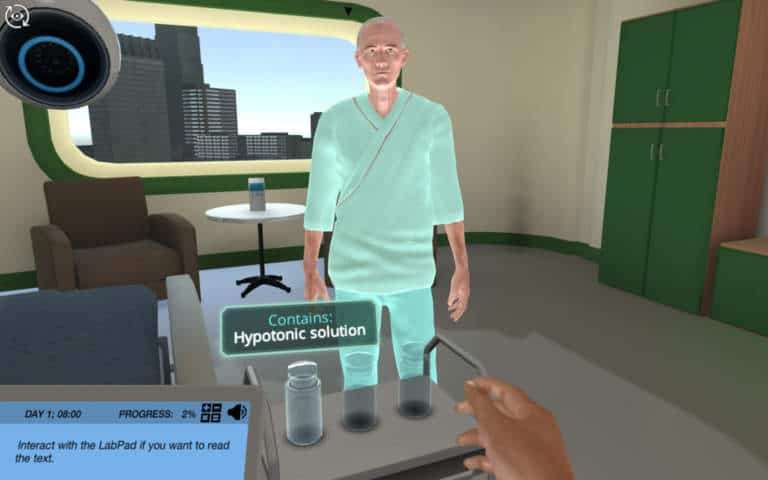Heading 1
Heading 2
Heading 3
Heading 4
Heading 5
Heading 6
Lorem ipsum dolor sit amet, consectetur adipiscing elit, sed do eiusmod tempor incididunt ut labore et dolore magna aliqua. Ut enim ad minim veniam, quis nostrud exercitation ullamco laboris nisi ut aliquip ex ea commodo consequat. Duis aute irure dolor in reprehenderit in voluptate velit esse cillum dolore eu fugiat nulla pariatur.
Block quote
Ordered list
- Item 1
- Item 2
- Item 3
Unordered list
- Item A
- Item B
- Item C
Bold text
Emphasis
Superscript
Subscript
About This Simulation
Help save Frank’s life by choosing the correct saline solution for an intravenous drip. Join Dr. One in the lab to discover what a hypotonic, isotonic and hypertonic solution is and how water is transported across the cell membrane in osmosis.
Learning Objectives
- Understand how solute concentration drives the movement of molecules across a semipermeable membrane
- Distinguish between osmosis and diffusion
- Define the terms osmosis and hypotonic, hypertonic and isotonic solutions
- Compare and contrast osmosis in hypotonic and hypertonic solutions
About This Simulation
Lab Techniques
- Determine isotonic point
- Microscopy
Related Standards
- HS-LS1-2
- 2.2 Water
- 11.3 The kidney and osmoregulation
- Biology 1.3 Membrane structure
Learn More About This Simulation
Choosing an IV fluid
You will meet Frank in the hospital. He is dehydrated because of sunstroke and needs extra fluids. There are three solutions available, but which one is the correct one to avoid damaging Frank’s blood cells?
Finding the isotonic point
Join Dr. One in the lab to understand exactly how water is transported across the cell membrane in osmosis. An animation will show you how the solute concentration of a solution can be equalized through diffusion and osmosis. You will see how solutes can move through the solution via diffusion and how water is transported across a semipermeable membrane in osmosis. You will then place potato cubes in a serial dilution of saline to see how water moves either into or out of the cells depending on the salt concentration.
Once you have plotted your results, you will be able to identify the isotonic point where the salt concentration of the solution is exactly the same as the salt concentration inside the cells. You will also see in which direction the water moves in both a hypotonic and a hypertonic solution. Finally, you can see the effect of hypotonic and hypertonic solutions on cells by adding these solutions to a blood sample and observing the red blood cells under the microscope.
Back to the hospital
After your experiments, you fully understand the three saline solutions that were available to Frank and the effect that the salt concentration will have on the cells in his blood. Review your hypothesis and advise Frank and his doctors on the correct IV solution.
For Science Programs Providing a Learning Advantage
Boost STEM Pass Rates
Boost Learning with Fun
75% of students show high engagement and improved grades with Labster
Discover Simulations That Match Your Syllabus
Easily bolster your learning objectives with relevant, interactive content
Place Students in the Shoes of Real Scientists
Practice a lab procedure or visualize theory through narrative-driven scenarios


FAQs
Find answers to frequently asked questions.
Heading 1
Heading 2
Heading 3
Heading 4
Heading 5
Heading 6
Lorem ipsum dolor sit amet, consectetur adipiscing elit, sed do eiusmod tempor incididunt ut labore et dolore magna aliqua. Ut enim ad minim veniam, quis nostrud exercitation ullamco laboris nisi ut aliquip ex ea commodo consequat. Duis aute irure dolor in reprehenderit in voluptate velit esse cillum dolore eu fugiat nulla pariatur.
Block quote
Ordered list
- Item 1
- Item 2
- Item 3
Unordered list
- Item A
- Item B
- Item C
Bold text
Emphasis
Superscript
Subscript
A Labster virtual lab is an interactive, multimedia assignment that students access right from their computers. Many Labster virtual labs prepare students for success in college by introducing foundational knowledge using multimedia visualizations that make it easier to understand complex concepts. Other Labster virtual labs prepare learners for careers in STEM labs by giving them realistic practice on lab techniques and procedures.
Labster’s virtual lab simulations are created by scientists and designed to maximize engagement and interactivity. Unlike watching a video or reading a textbook, Labster virtual labs are interactive. To make progress, students must think critically and solve a real-world problem. We believe that learning by doing makes STEM stick.
Yes, Labster is compatible with all major LMS (Learning Management Systems) including Blackboard, Canvas, D2L, Moodle, and many others. Students can access Labster like any other assignment. If your institution does not choose an LMS integration, students will log into Labster’s Course Manager once they have an account created. Your institution will decide which is the best access method.
Labster is available for purchase by instructors, faculty, and administrators at education institutions. Purchasing our starter package, Labster Explorer, can be done using a credit card if you are located in the USA, Canada, or Mexico. If you are outside of North America or are choosing a higher plan, please speak with a Labster sales representative. Compare plans.
Labster supports a wide range of STEM courses at the high school, college, and university level across fields in biology, chemistry, physics, and health sciences. You can identify topics for your courses by searching our Content Catalog.















